Neurones (AQA A Level Biology) : Revision Note
Myelinated Motor Neurones
Information is sent through the nervous system as nerve impulses – electrical signals that pass along nerve cells known as neurones
A bundle of neurones is known as a nerve
Neurones coordinate the activities of sensory receptors (eg. those in the eye), decision-making centres in the central nervous system, and effectors such as muscles and glands
Neurones have a long fibre known as an axon
The axon of some neurones is insulated by a fatty sheath with small uninsulated sections along its length (called nodes of Ranvier)
The sheath is made of myelin, a substance made by specialised cells known as Schwann cells
Myelin is made when Schwann cells wrap themselves around the axon along its length
The presence of Schwann cells means that the electrical impulse does not travel down the whole axon, but jumps from one node to the next
The 'jumping' of the electrical impulse between nodes of Ranvier is called saltatory conduction
This speeds up the conduction of the impulse and its transfer from one cell to another
Neurone cell bodies contain many extensions called dendrites
This means they can connect to many other neurones and receive impulses from them, forming a network for easy communication

An example of a neurone
There are three main types of neurone: sensory, relay and motor
Sensory neurones carry impulses from receptors to the CNS (brain or spinal cord)
Relay (intermediate) neurones are found entirely within the CNS and connect sensory and motor neurones
Motor neurones carry impulses from the CNS to effectors (muscles or glands)
Each type of neurone has a slightly different structure
Motor neurones have:
A large cell body at one end, that lies within the spinal cord or brain
A nucleus that is always in its cell body
Many highly-branched dendrites extending from the cell body, providing a large surface area for the axon terminals of other neurones
Examiner Tips and Tricks
You are not expected to know the structure of sensory and relay neurones. However it can be helpful to memorise the key identfiying features of motor neurones – such as the location and size of the cell body.

You've read 0 of your 5 free revision notes this week
Sign up now. It’s free!
Did this page help you?

